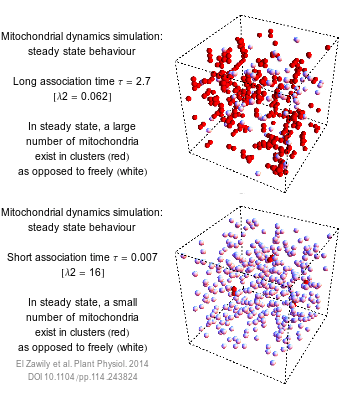Mitochondria are often likened to the power stations of the cell, producing energy that fuels life's processes. However, compared to traditional power stations, they're very dynamic: mitochondria move through the cell, and fuse together and break apart (among other things). Interestingly, their ability to move and undergo fusion and fission affects their functionality, and so has powerful implications for understanding disease and cellular energy supplies.
Because of this central role, it is important to understand the fundamental biological mechanisms that govern mitochondrial dynamics. Several important genes controlling mitochondrial dynamics are known in humans (and other organisms), but plant mitochondria (despite the fundamental importance of plant bioenergetics for our society) are less well understood.
Our collaborators, David Logan and his team, working with a plant called Arabidopsis, observed that a particular gene, entertainingly called "FRIENDLY", affected mitochondrial dynamics when it was artificially perturbed. (This approach, artificially interfering with a gene to explore the effects that it has on the cell and the overall organism, is a common one in cell biology.) We've just written a paper with them "FRIENDLY regulates mitochondrial distribution, fusion, and quality control in Arabidopsis" (free here) exploring these effects. Plants with disrupted FRIENDLY had unusual clusters of mitochondria in their cells, their mitochondria were stressed, and cell death and poor plant growth resulted.
Our collaborators, David Logan and his team, working with a plant called Arabidopsis, observed that a particular gene, entertainingly called "FRIENDLY", affected mitochondrial dynamics when it was artificially perturbed. (This approach, artificially interfering with a gene to explore the effects that it has on the cell and the overall organism, is a common one in cell biology.) We've just written a paper with them "FRIENDLY regulates mitochondrial distribution, fusion, and quality control in Arabidopsis" (free here) exploring these effects. Plants with disrupted FRIENDLY had unusual clusters of mitochondria in their cells, their mitochondria were stressed, and cell death and poor plant growth resulted.
 |
| Simulation of mitochondrial dynamics |
We used a 3D computational and mathematical model of randomly-moving mitochondria within the cell to show that an increased "association time" (the friendly mitochondria stick around each other for longer) was sufficient to explain the experimental observations of clustered mitochondria. Our paper thus identifies an important genetic player in determining mitochondrial dynamics in plants; and explores in substantial detail the intra-cellular, bioenergetic, and physiological implications of perturbation to this important gene. Iain and Nick
